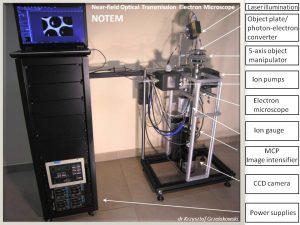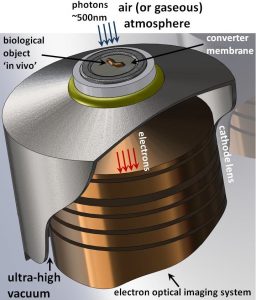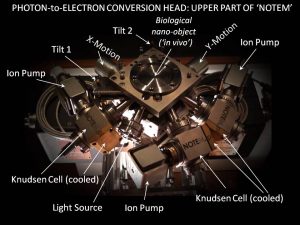NOTEM: Near-field Optical Transmission Electron Microscope®

The subject of invention is the Near Field Optical Transmission Electron Emission Microscope NOTEM: an analytical imaging instrument dedicated to optical inspections and observations of different objects via transmissive electromagnetic radiation. However, our unique solution utilizes in the process of final image creation not photons, as in conventional optical microscopes, but electrons generated in the near-field regime by the original optical image. In consequence, a much higher lateral resolution far below a diffraction limit for photons can be reached.
In its principle of operation, function and applications, the invented microscopy relates to a number of different research fields and imaging of:
1) objects in any physical state, located under vacuum as well as in the air (or gaseous) atmosphere under arbitrary pressure (also under overpressure), including thin film insulators, semiconductors, conductors and superconductors, dielectrics, ferro-, piezo-, para-electrics, dia-, para-, ferro-, antiferro, and ferri- magnetics, chemical compounds and substances, minerals, etc., organic, inorganic matter, living matter, i.e. any biological material (also ‘in vivo’ in its natural environment or exposed to an air or arbitrary gaseous atmosphere) or fluids,
2) processes, e.g. physical, chemical, physico-chemical, electro-chemical, temperature dependent, magnetical, electrical, etc. (also in situ and in real time), with secondary electrons generated as a result of conversion of the object penetrating electromagnetic radiation: non-polarized or polarized linearly, circularly/elliptically, e.g.: synchrotron radiation, X-Ray, laser light, UV-light or visible light, etc.
The terms “photon” and “electron” that occur in the nomenclature of invention of the Near-field Optical Transmission Electron Microscope determine its relationship to the two wide classes of imaging techniques simultaneously: optical and electron microscopy.
The subject of invention: ‘Near-field Optical Transmission Electron Microscope’ refers to the unification in a one common system the two different imaging mechanisms and their instrumental implementations: 1) optical imaging in the near-field regime or close to it, i.e. lateral resolution ‹ 20nm and 2) secondary electron imaging of (P)EEM type microscopy (“cathode lens objective” based (Photo)Emission Electron Microscopy).

This unification is performed by an application of the unique photon-electron converter that transforms the primary optical image of observed object (formed in the near-field regime in the photoemissive nano-layer) to the correlated secondary photoelectron image, that becomes now an object of magnification for the cathode lens based imaging system. Thus, the proposed imaging concept enables a conventional optical microscopy of the e.g. living matter under its natural conditions with photons (on the air side), but directly followed (within the near-field range) by the subsequent electron image formation (on the vacuum side) assuring the extremely high lateral resolution due to the near-field regime in optical and far-field regime in electron imaging. The final lateral resolution of < 20nm in the “optical microscopy scheme” can be obtained, even in the case of a living microorganisms like bacteria or structures like viruses (vide coronaviruses, e.g. SARS-CoV-2). It allows the realization of the unique ′in vivo′ experiments on the nanometric scale carried out in the real time with the biological objects in their natural (or simulated) environment (alternatively under external stimuli)- obviously unavailable in the case of conventional electron microscopy and its intrinsic ′post mortem′ sample preparation regime.
Our novel imaging technique is protected by a number of international patents.
We are interested in a scientific and commercial collaboration, proposals and grants formulation, etc.